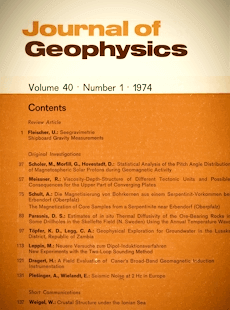Palaeomagnetism of tertiary volcanic rocks from the Ethiopian southern plateau and the Danakil block
Article Sidebar

Vols. 1-18 (1924-1944), ISSN 0044-2801
Main Article Content
Abstract
Remanent magnetization of 92 samples (22 sites) collected from Oligocene basalts from the Ethiopian southern plateau (location 9.1°N, 41°E) yields a palaeomagnetic pole at 75.1°N, 170.3°E with A95 = 6.4° after AF-cleaning. This pole agrees with the Eocene-Oligocene pole for the western plateau. Palaeomagnetic data of 125 samples (26 sites) from Early Pliocene basaltic rocks from the Danakil block (12.7°N, 42.5°E) yield a pole at 79.5°N, 258.8°E with A95 = 2.6°. The deviation of this pole position from other Miocene Pliocene poles for Africa is consistent with the hypothesis of 10° counter-clockwise rotation of the Danakil block since the Early Pliocene. On theoretical grounds however this amount of deviation may also be caused by not having completely averaged out secular variation due to insufficient sampling.
 ARK: https://n2t.net/ark:/88439/y042442
ARK: https://n2t.net/ark:/88439/y042442
Permalink: https://geophysicsjournal.com/article/277
Article Details
References
Barberi, F., Tazieff, H., Varet, J. (1972b) Volcanism in the Afar depression: its tectonic and magmatic significance. Tectonophysics 15:19-29
Brock, A. (1971) An experimental study of palaeosecular variation. Geophys. J. 24:303-317
Brock, A., Gibson, I.L., Gacii, P. (1970) The palaeomagnetism of the Ethiopian flood basalt succession near Addis Ababa. Geophys. J. 19:485-497
Burek, P.J. (1970) Palaeomagnetic evidence for an anticlockwise rotation of the Danakil Alps. Trans. Am. Geophys. Union 51:4
Megrue, G.H., Norton, E., Strangway, D.W. (1972) Tectonic history of the Ethiopian rift as deduced by K-Ar ages and palaeomagnetic measurements of basaltic dikes. J. Geophys. Res. 77:5744-5754
Mohr, P.A. (1971) Ethiopian rift and plateaus: Some volcanic petrochemical differences. J. Geophys. Res. 76:1967-1982
Mohr, P.A. (1972) Surface structure and plate tectonics of Afar. Tectonophysics 15:3-18
Pouchan, P., Roche, A. (1971) Etude palfomagnetique de formations volcaniques du Territoire des Afars et Issas. Compt. rend. 272D:531-534
Raja, P.K.S. (1968) A palaeomagnetic study of some East African rocks. Ph.D. thesis, University of London
Reilly, T.A. (1970) Some palaeomagnetic results from central East Africa and the Seychelles Islands. Ph.D. thesis, University of London











